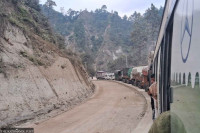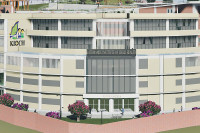Editorial
What kind of Kathmandu?
For Mayor Shah, crafting an eco-friendly and equitable melting pot of people and ideas is a more worthy goal to aspire to.
The city of Kathmandu is a lot cleaner than it was, say, a year ago. Mayor Balendra Shah has done a great job managing roadside garbage, removing dust particles from streets, and adding much-needed greenery to the concrete jungle. He has also started the process of removing loose wire, set up shelters for stray cattle and even started a facility to separate biodegradable waste from the non-degradable kind. The revamped image of Kathmandu is testament to the fact even a single person can bring meaningful change to people’s lives. That is the good part about Mayor Shah. Yet what we have seen during his year and a half in office is a tendency to “bulldoze” his way to development. To make the pavements pedestrian-friendly, Shah has often used force to clear away street vendors. The city police have upturned vegetable and chatpate carts, even as their owners begged for a smidgen of mercy. The city police have been as ruthless in their determination to remove riverside squatters.
This brings us to a central question: Who is this city for? Is it a home only for those with permanent houses and established businesses and jobs? What about thousands of people of lesser means who are forced to work by the road and to live in makeshift shelters? Don’t they have the right to live and work respectfully in their own country? Curiously, last week, when a group of youngsters were protesting outside the Lalitpur Metropolitan City offices demanding that street vendors there be treated with respect, there were counter-protesters who held that pavements are meant exclusively for walking and there is no question of adjusting street vendors. Kathmandu Valley has always treated those from the outside with a bit of disdain. Ensconced in their material comfort, they also loathe the idea of adjusting even a bit in order to ease the lives of people of lesser means.
Again, coming back to Kathmandu and Balendra Shah, we believe there is a middle way whereby the city can be kept clean and green while the small traders also get to regularly fill their tummies. The reason plans for dedicated areas where street vendors can ply their trade or for the resettlement of refugees have not worked is that the KMC has gone about it in a rather haphazard way. There was little homework on how to develop alternate centres for commerce or housing. For instance, in the case of street vendors, Singapore’s hawker culture offers a useful lesson.
Now recognised by Unesco as an ‘intangible cultural heritage of humanity’, these “community dining and culinary practices in a multicultural urban context… serve as ‘community dining rooms’ where people from diverse backgrounds gather and share the experience of dining over breakfast, lunch and dinner.” The UN body notes that as a social space that embraces people from diverse socioeconomic backgrounds, hawker centres play a crucial role in enhancing community interactions and strengthening the social fabric. No, we don’t think similar centres can sprout up in Kathmandu overnight. It will be a long-term project. But a start must be made. Moreover, for a highly driven person like Mayor Shah who also has higher political aspirations, crafting an eco-friendly and equitable melting pot of people and ideas is a more worthy goal to aspire to. If someone can pull this off, it’s him.




 6°C Kathmandu
6°C Kathmandu














